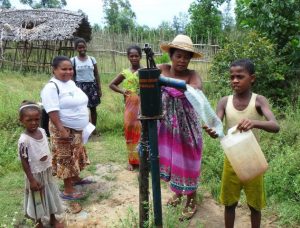 |
|
Functioning hand pump constructed in 2016 |
What is the JWF Fund?
The JWF Fund was founded in 2005 and solely operated by Japan Water Forum (JWF), which aims to support selected grass-roots organizations in developing countries who have been addressing water-related issues in their own countries. Every year, JWF publicly seeks for projects and those adopted after due assessment will be eligible to get funding up to 1,000 USD per project.
The JWF Fund is based upon membership fees of the JWF members and donations from general contributors through the Charity for Water run by JWF.
The JWF Fund 2017 was conducted where 7 projects from 6 countries were selected out of 211 projects submitted from 31 countries.
What is the follow-up observation
Our priority is placed in responding to the issues and needs of the field in an efficient and effective way.
To grasp changes of the issues and needs after completion of the projects, we decided to carry out follow-up observations for the projects in 2014, and since then we have collected information on effects and impacts of the projects.
The JWF Fund 2016 supported 6 projects one each in Madagascar, Tanzania, Togo, Pakistan and two in India.
As a result of our request, we received consents from 3 organizations out of 6 who were supported by the Fund in 2016.
With their cooperation, the follow-up observations were carried out to see the conditions, one year after the completion.
The results of the observations are described below.
Report
Japan Water Forum Fund 2016 follow-up report (PDF)
Out line of the projects in JWF Fund 2016 and Follow-up results in 2017
1. Clean water and WASH*1 education for the Ampandroantsiriry’ community (Madagascar)
(1) Outlines of the project of JWF Fund 2016
・Organization: Grassroots Climate and Livelihood Actions (GRACLIA) (#108)
・Project title: Clean water and WASH education for the Ampandroantsiriry’ community
・Country/Area: Madagascar/Antsinanana
・Period: November 2016 to March 2017
・Number of beneficiaries 600 people: (170 women, 180 men, 250 children)
・Cost: 985.9 USD (JWF Fund: 977.5 USD, contribution from beneficiaries : 8.4 USD)
*1:Water, Sanitation and Hygiene
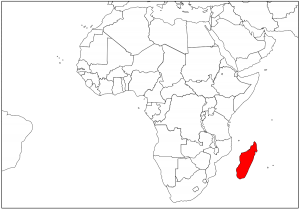 |
| Madagascar |
Background
Madagascar has approximately 22 million populations, with the majority, which represent 80% of the population, living in rural areas, where the public services and facilities are almost inexistent or to the minimum. In the village of Ampandroantsiriry, due to a lack of access to clean water for the local people, especially women and children have to walk hundreds meters from their village to nearby streams to wash their dishes and clothes, and fetch water. The stream is used by the local community as main source of water for drinking and cooking. On the other hand, addition to washing dishes and clothes, the majorities of the communities’ members defecate in the surrounding areas since there is no toilet facility. As a result the local community is exposed to infections such as cholera, diarrhea, and typhoid. Furthermore, there is a dumping site few hundred meters upstream which pollutes water stream.
Outputs
1)Village meeting was held.
2)3 hand pumps were installed.
3)Water user committees were established.
4)3 workshops of Sur’eau were conducted
5)Clean up campaign of the dumping site was carried out.
Because of these activities, the residents of the Ampandroantsiriry’ community could drink safe drinking water so that reduction of diseases caused by tainted water can be expected.
(2) Results of the follow-up observation in 2017
- Hand pumps
– Two out of three functioning hand pumps are still usable daily by the local people; however, the other one has not been used due to inadequate location.
– The third hand pump is located near rice fields and the water smelt mud, and the smell worsened after the rainy season.
– The capacity of two hand pumps weren’t enough for the needs of the Ampandroantsiry community. As a result, some people are still going to the river to wash clothes and sometimes to take a bath. The local people reported that sometimes they have to wait for a few minutes, after use of the pump, to get water again from the pump. For those who cannot wait, they use the water from the pumps for cooking and drinking only and still use the river for their other needs. - Water User Committee
The Water Committee of the functioning hands pumps is functioning. They managed to collect money from the pump users when the pumps needed to be repaired, and the fees were collected only when the pumps needed repairing.
The presidents of the Water User Committees were good at mobilizing the pump users and settling differences among the users. - Dumping site
After the project in 2016, the dumping site was closed. There had been no problem occurred after the dumping sites located upstream of the river was closed, because people who used the dumping site were those from the city which is 15 km away from the village and most of the dumping was industrial garbage. Now the local people are using the dumping site for crop farming. - Change of people in the Ampandroantsiriry community
– Community solidarity built during and after the installing of the pumps in taking care of the pumps, especially with the two functioning hand pumps. Furthermore, more people want to have pumps in their villages to stop using the dirty water from the river.
Voices from the beneficiaries:
- Ms. Bana, 36 years old, President of the water committee
I have used the hand pump and it was very helpful for me and my family because it’s located not far from our home. Furthermore, the water from the pump is cleaner than that of the streams we usually used before. I’m very happy with it and the other people around here as well; it improved many people’s lives around here. - Ms. Veroboda, 45 years old, participant of Sur’eau workshops
The hand pump is very important to us and we use it every day. It makes our life easier. The pump is helping us a lot, we use less time in fetching water, and also the water from the hand pump is better than the stream we were using. Whenever I can, I fetch the water myself instead of asking my daughter to do so, because the pump is near and I need less help, which gives my daughter more time for her schoolwork or other tasks. - Ms. Nela, 8 years old
I’m using the hand pump and I like it, because it is near our home and we don’t have to walk far. My family prefers using the water from the pump to the streams; we also have clean water at home for drinking or for cooking. And also I don’t have to go far anymore to fetch the water after school.
 |
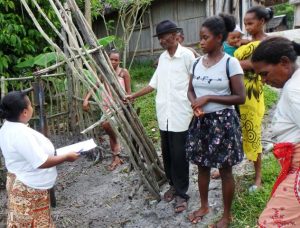 |
|
Functioning hand pump constructed in 2016 |
Interview to residents nearby the hand pump which is not function |
2. Rainwater Harvesting for water conservation and dry land farming for tribal farmers (India)
(1) Outline of the JWF Fund 2016 project
・Organization: PRAGATI KORAPUT (#424)
・Project title: Rain water Harvesting for water conservation and dry land farming for tribal farmers
・Country/ Area: India/Koraput
・Project period: November 2016 to April 2017
・Number of beneficiaries: 18 families, 102 people
・Cost: 1,366.95 USD (JWF Fund 983 USD, contribution from community 132.35 USD, contribution from PRAGATI KORAPUT 251.5 USD and others)
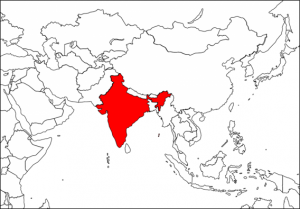 |
| India |
Background
There are 18 small and marginal farmers who have their agriculture field of 17.5 acres growing millets, vegetables and pulses during the rainy season. In addition to the shape of land sloped and undulating, due to torrential rains with intensity of 150 to 200 mm per hour, heavy runoff of rainwater causes soil erosion and damages crops of the farmers almost every year. Contrarily, with the end of monsoon rains, the lands dry up as the moisture retention capacity of the soil is very low. Due to the undulating terrain, the land is unsuitable for agriculture. Over the years, due to erosion of topsoil and infertility of land, the productivity of the land has been declining. Therefore, the farmers who own the lands are reluctant to grow crops even during the rainy season, and rather they want to work as wage laborers in the nearest town to support their living. Some of the farmers also earn their living by selling firewood and charcoals, which causes further forest destruction.
Outputs:
1)Concept sharing meeting was held.
2)User Group was established.
3)Rainwater harvesting structure and drainage were constructed.
Because of these activities, it became possible for the target farmers to cultivate crops throughout the year so that their stable earnings can be expected.
(2) Results of the follow-up observation in 2018
- Rainwater harvesting structure and drainage
Effect of the constructed facility: After completion of the project in April 2017, the rainy season started from June to September 2017. During this period, the structure created under the project helped harvesting the rain water. Despite of several heavy rains, the runoff water was collected in the structure through the inlet and the surplus water was channelized through the outlet, which reduced damage of both crops and lands. - User Group
The structure is maintained properly as the User Group members are involved in taking the responsibility for its maintenance. The beneficiary farmers who are using the water for crops have formed a user group who are taking responsibility in cleaning and maintenance of the structure. The farmers were motivated to start their own maintenance fund out of the income they earn during a cropping cycle. As it was planned and implemented based on the need of the farmers, they are confident to take ownership in maintaining the structure. - Change of farmers life
The farmers are able to utilize their lands to grow crops throughout the year enabling them to produce additional food and earn supplementary income to support their livelihood needs. In the long run, it will not only arrest soil erosion, but also increase moisture retention capacity of the lands, ultimately restoring soil fertility and contributing to increased productivity.
Voices from the beneficiaries
- Mr. Raju Santa, 45 years old, owner of a half-acre of land
I cultivate finger millet in my half acre land adjacent to the rainwater harvesting structure. I could harvest 3 quintals of the finger millet by adopting the new technology of the system for millet intensification. I feel happy that it will meet the consumption need of my family for additional 6 months. Earlier, I used to grow millets in the forest land and the harvest was not even enough for 3 months, so I had to buy millets from the market. - Mr. Dibakar Jani, 46 years old
I cultivate maize, finger millets and tomatoes in my land near the rain water harvesting structure. I took millets and maize for my household consumption and sold tomatoes in the nearby market.
Thanks to the rain water harvesting structure, my land was protected as the rain water was harvested. This year my crops and lands were protected from heavy run offs. We could get water to save my crops during the dry spell in the rainy season. - Trinath Santa, 25 years old
I have utilized the facility for watering my crops during the dry spell of rainy and winter seasons. My family grow millets during the rainy season which is a regular part of our daily diet.
My land was not affected by heavy runoffs of the rain water during the rainy season. I am now growing vegetables in the land. The villagers are now aware of the importance of the rain water harvesting. My family members now grow regular crops in the land. As they now work in the land, they need not go out of the village to look for work.
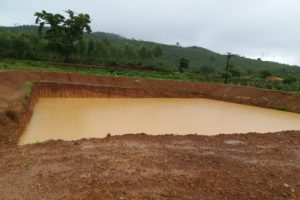 |
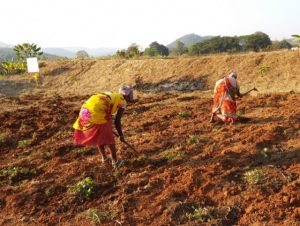 |
|
Rainwater harvesting structure constructed in 2016 (In rainy season) |
Women cultivating farmland nearby the structure |
3. Promote WASH in Schools through Refurbishment of Toilets & Drinking Water System and Construction of a Hand Washing Station in Rajasthan, India (India)
(1) Outlines of the project of JWF Fund 2016
・Organization: PHD Rural Development Foundation (PHDRDF) (#449)
・Project title: Promote WASH in Schools through Refurbishment of Toilets & Drinking Water System and Construction of a Hand Washing Station in Rajasthan, India
・Country/Area: India/Sikar District
・Project period: November 2016 to April 2017
・Number of beneficiaries (Direct and Indirect): 272 people (140 girls, 120 boys and 12 teachers) and 1,360 people
・Cost: 1,149 USD (JWF Fund: 1,000 USD and contributions from PHDRDF: 149 USD)
 |
| India |
Background
The difficulty to access water and the low per-capita income of the district have impacted the sanitation conditions among the rural population including the schools, where existing sanitation facilities were in a deplorable condition and cannot be used by students. Poor financial resources have prevented rehabilitation of old broken sanitation structures. Students could not use the toilets because of lacking water. A lack of funds and water connection has led to its long-term neglect and excessive damage. This causes absenteeism, especially of girls. Girls had to go home to use toilets and the boys defecated in the open.
Outputs
1)Pre assessment survey was conducted.
2)Existing toilets were refurbished.
3)Hand washing facilities were constructed.
4)Water quality test was carried out.
5)WASH Committee was established.
6)2 WASH Sessions were held.
7)Follow up and Feedback was carried out.
Because of these activities, the school students and teachers could make use of water throughout the year so that improvement of their leaning environment can be expected.
(2) Results of the follow-up observation in 2018
- Refurbished toilets
– Usage of the toilets: Refurbished toilets for girls, boys and teachers are functioning and used well. Earlier, the students were practicing open defecation due to non-functional toilets and also they did not have hand washing facilities available in the school.
– A positive behavior change towards using sanitation facility rather than open-defecation, is being observed among the students as well as the teachers. This is very beneficial especially for girl students as now they do not have to go far locations for open defecation, but have a safe space inside the school for the same. - Hand washing facility in girls toilet
The hand washing facility of the girls’ toilet is functioning well; construction of hand washing station has led to increase hygienic practices by the students. - Drinking and hand washing water facility with taps and Soak Pit
Immediately after the renovation of the drinking water facility in 2016, the water from the facility was not potable. Therefore, students use it only for handwashing.
After that, the local government has been very supportive towards the needs of the school and has extended help to get the water treated. The water is now considerably safe for drinking purposes.
The students are now using the water from the hand washing and the drinking water station. - WASH Committee
The WASH Committee is in place and functioning well. It includes both teachers and students to ensure that the hand washing ritual is practiced before the lunch hour and the students use and maintain the toilets regularly. - Changes of students, teachers and school authorities
– It has been observed that not only do the sanitation facilities remain clean but the students are also very happy as using toilet facilities has become convenient for them and they now feel like attending school.
– The teachers have also become sensitive towards cleanliness and have now begun to follow hygienic sanitation habits and directing the students to follow the same.
Voices from the beneficiaries
- Mr. Satya Veer, School headmaster of the school
There have been positive changes among the students as they have become aware of the hygienic habits to be followed. The students have started the practice of washing hands which has led to reduced incidences of water borne diseases among them. The school now looks clean and has gotten a beautiful surrounding. Moreover, the students now like coming to school more regularly. - Mr. Vijay Prakash, teacher of the school
– I use the sanitation facilities at the school and found out that they are were good and safe. I have now realized that it is very important to have proper sanitation facilities and practice hygienic behavior, at school and at home, so as to keep one fit and healthy.
– Now all the students, especially the girls have a safe space to access the toilet. This has also improved their daily attendance. Now, the students regularly take part in the group hand washing session. The painting of hand washing steps has helped the students in properly washing their hands. - Mr. Arjun Lal, student of the school
I am very happy after using the toilet facilities in my school. Earlier, there were no toilets in the school and we used to go to the nearby field, also we did not have a proper handwashing and drinking water station in the school – it was rusted making it unsafe.
My friends and I are very happy to use the toilets inside the school and to use the new colorful drinking water/handwashing station.
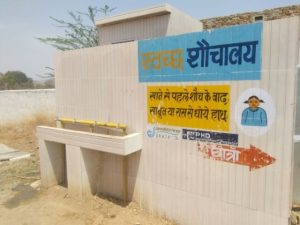 |
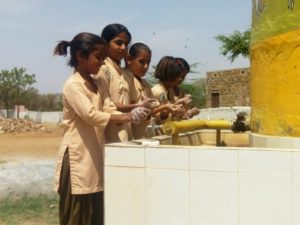 |
| Refurbished toilet for girls in 2016 | Hand washing session |
(Reported by Akie Gunji, Manager)
